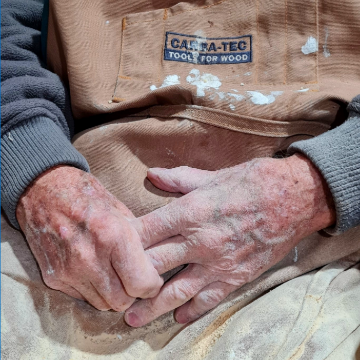The Joy of Mucking about with Wood
Author Tony O'Brien, Henty Men's Shed.
Sheds are collecting places for all sorts and occasionally some of the fellows have particularly useful skills.
Pictured are hands that reflect a lifetime of work in a range of fields, but particularly woodwork.
Ninety-three-year-old, Bruce Young, a Life Member of the Henty Men’s Shed in the Riverina region of New South Wales, is starting to slow and now must sit down more often.
However, in the picture you can see that they are not idle hands, but ready to have a crack at any challenge.
Bruce has been a long-term supporter of the Carbatec business, as is attested by the battered apron.
His productivity has included house building, making all the kitchen benches, cupboards and wood trims.
Not satisfied with the household activities, he has tackled farming, cropping, irrigation and stock, as well as maintaining valued poultry bloodlines, over his 90 + years.
Bruce’s dominant characteristic is clearly displayed in the phrase,” I’ll do that for you”.
The President of the Henty Men’s Shed, Neil Meyer, describes Bruce as “a thoroughly genuine country gentleman”.
When Bruce accepts invitations, he still dons formal attire, and is ready 30 minutes before the agreed time.
Now a little hard of hearing, with dimming vision and weary bones, Bruce still has all his fingers – a real tribute to his skills in the decades before modern industrial safety developments.
Despite the passage of time, he is still ready to sit by the fire in the shed and rub down a fine piece of timber.
He sums up the value of the woodworking theme in his life, as giving a sense of real satisfaction on completion, a sense of delight at other people’s reaction to the job, and a real sense of personal accomplishment when looking back at completed work.
“You’ll need a different grit!”. The exclamation was firm, and definitive about the choice of the sandpaper, but also clearly a true reflection of the speaker.
The Henty Men’s Shed approves the use of its name in this context.
Henty Men's Shed Incorporated
67 Sweetwater Drive, Henty NSW 2658
info@hentymensshed.org.au
Photo: Tony O’Brien |